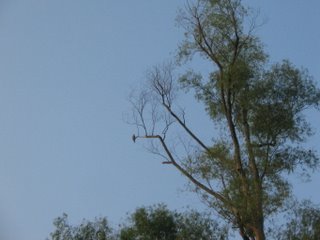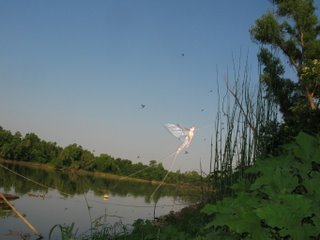Gars, Kites, and Mayflies

Sunup on the river this morning.
The mayfly emergence is three days old now, and it is diminishing but not over. What kind of feeling is it that you get when this is out in front of you? Wonder, for sure, but awe also, and curiosity at the different things that come to the rich table of insect protein. It just seems that everything out there eats them. I guess that’s not so good for the individual mayflies but it sure is good for everything else.
Here are a few things I saw this morning at sunup. First of all, the gars. They are shortnose gars and they are everywhere, just skimming the
 surface of the river with their noses just under the water. This species is not large; most of them are between two and three feet long. You can easily see a hundred of them at one time, and they can see you but they don’t seem to care. They sit there just below the surface and fan their fins and tail just enough to make a little headway against the mild current, or just to maintain a position and let the current flow by them. As floating mayflies come by, the gars just inhale them, almost lazily. This is happening all across the river and the river is 400 feet wide. The pic shows three gars that have found some mayflies and are taking care of business. Of the other three common species of gars -longnose, spotted and alligator - I saw nothing.
surface of the river with their noses just under the water. This species is not large; most of them are between two and three feet long. You can easily see a hundred of them at one time, and they can see you but they don’t seem to care. They sit there just below the surface and fan their fins and tail just enough to make a little headway against the mild current, or just to maintain a position and let the current flow by them. As floating mayflies come by, the gars just inhale them, almost lazily. This is happening all across the river and the river is 400 feet wide. The pic shows three gars that have found some mayflies and are taking care of business. Of the other three common species of gars -longnose, spotted and alligator - I saw nothing.That’s below the water; above the water are the kites. They swoop down and up and back and around, and up again. They are catching mayflies in an almost casual way, nothing hurried or like that. Sort of like the gars, taking care of business. Some of the kites were close enough to follow the details (with binoculars) of what they were doing. I p
 icked out one in particular and stayed with it. As it flew it would go along and seem to just reach out with a foot and pick mayflies out of the air, and then transfer the insect to its mouth. Sort of routine, no big deal, but maybe just efficient rather than routine. As I watched and timed it, it caught 22 mayflies, one at a time in one minute. What’s that? 1320 in one hour? Surely they can’t eat that much, so maybe half of that for breakfast? And they may be feeding young so you have to allow for that too, I guess. The one in the tree is full of food, for sure.
icked out one in particular and stayed with it. As it flew it would go along and seem to just reach out with a foot and pick mayflies out of the air, and then transfer the insect to its mouth. Sort of routine, no big deal, but maybe just efficient rather than routine. As I watched and timed it, it caught 22 mayflies, one at a time in one minute. What’s that? 1320 in one hour? Surely they can’t eat that much, so maybe half of that for breakfast? And they may be feeding young so you have to allow for that too, I guess. The one in the tree is full of food, for sure. On the banks of the river, the more terrestrial fauna is also taking advantage. Along the water’s edge there are centipedes, ground spiders and tiger beetles scavenging dead and dying mayflies. Not to mention the spiders with webs, all overcome with bounty - all with destroyed webs with mayfly carcasses hanging all over them. If spiders had freezers they could sure stock up for the winter. Wow.

A cardinal crashes into a low-hanging bush and a cloud of mayflies erupts from it, forming a hazy smoke of insects around the bird. It picks what it wants while just sitting still on a branch and then flies off. How do they learn to crash into the vegetation? Is it really to flush the insects? Or is it coincidence? They don’t seem that clumsy at other times. The picture is one mayfly that is frozen in motion by the flash. Instead of the few you see behind it, think of ten thousand against the sky at sundown tonight.
The river is still at 4.4 on the Butte La Rose gauge, not changing much for a while. Same with the Ohio and Mississippi.
Rise and Shine, Jim


0 Comments:
Post a Comment
<< Home